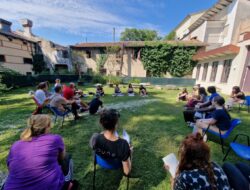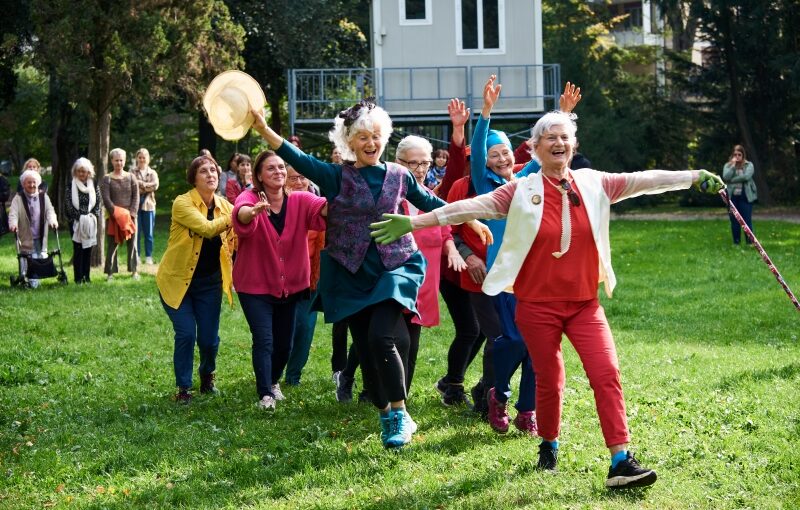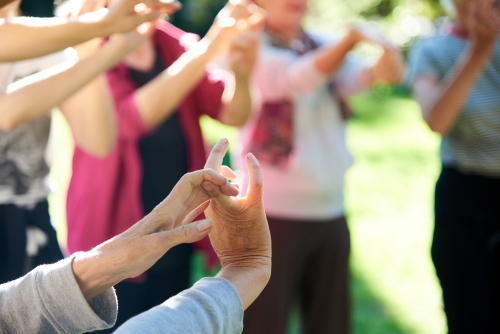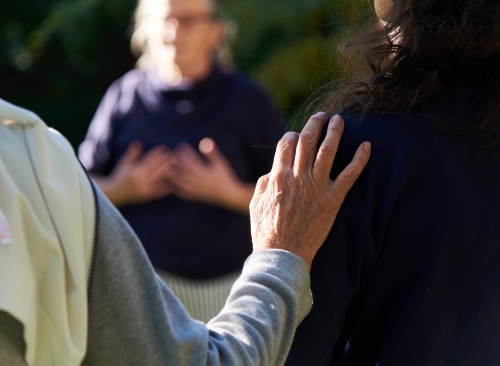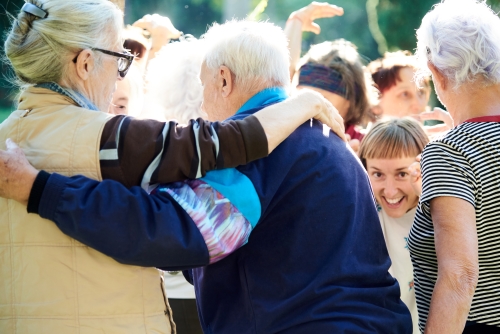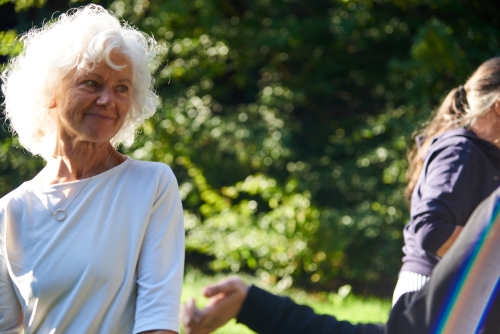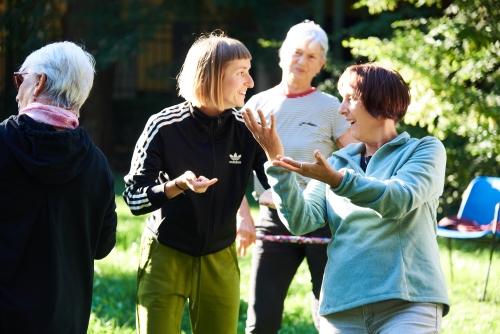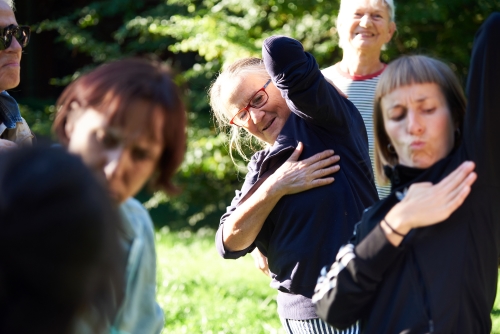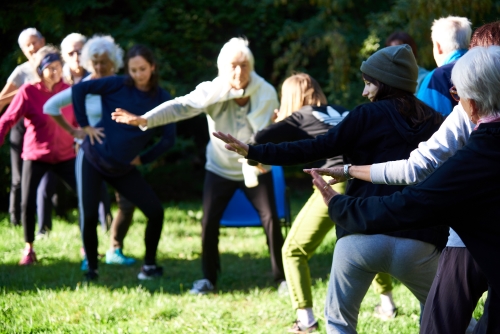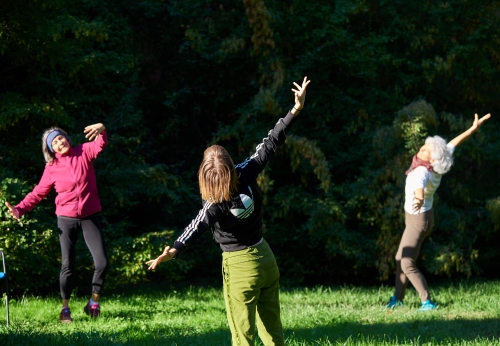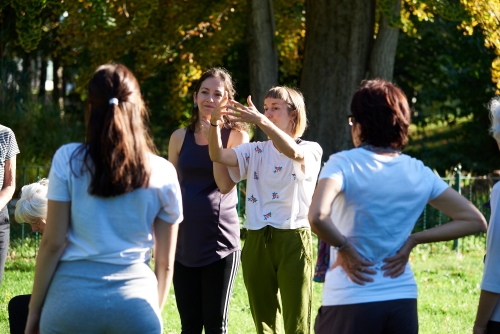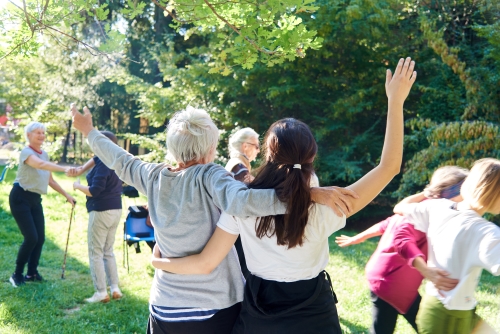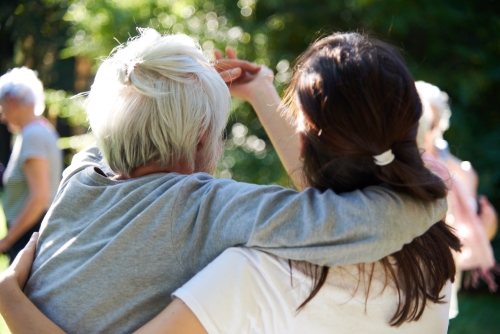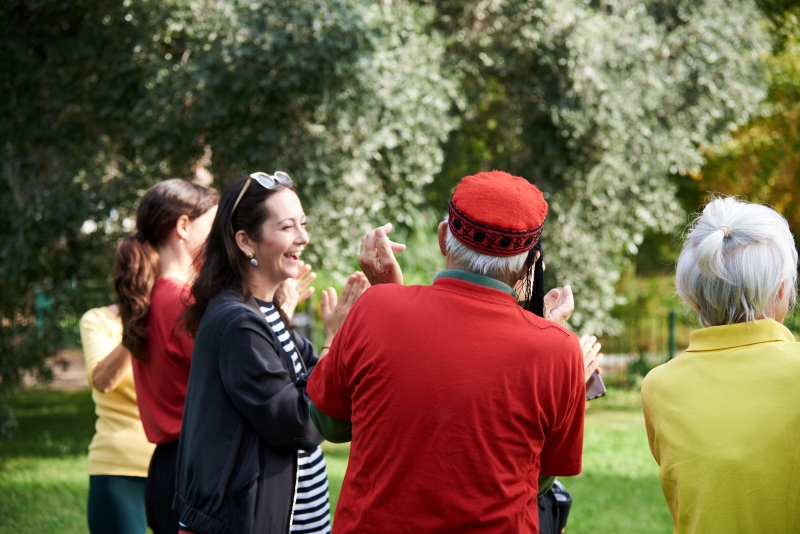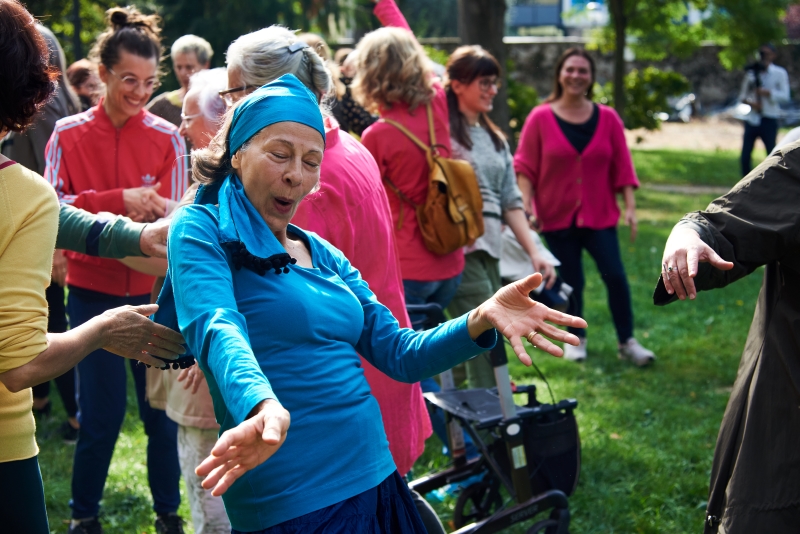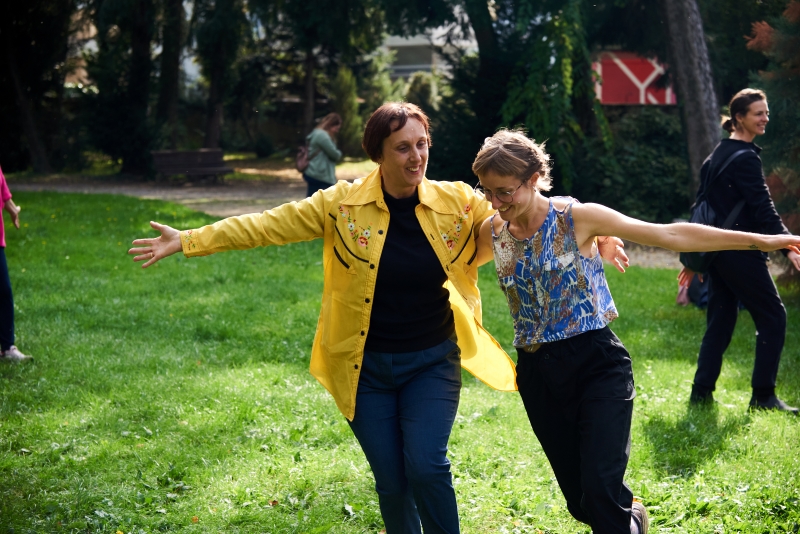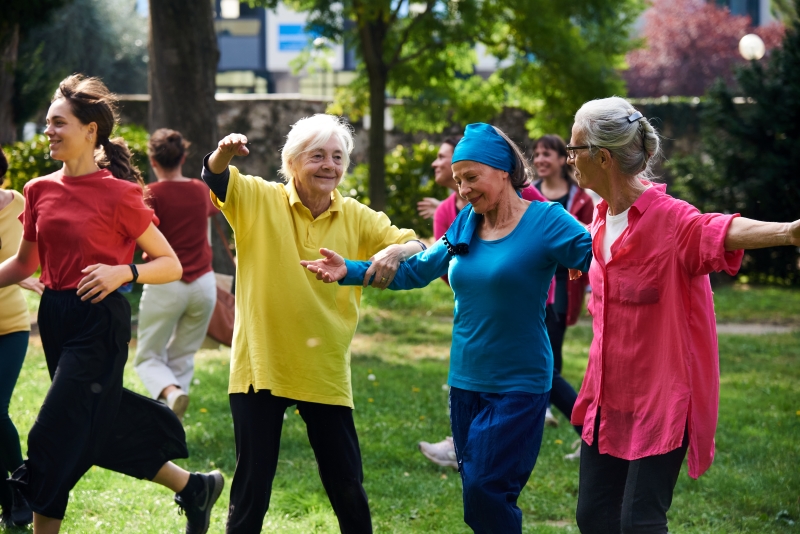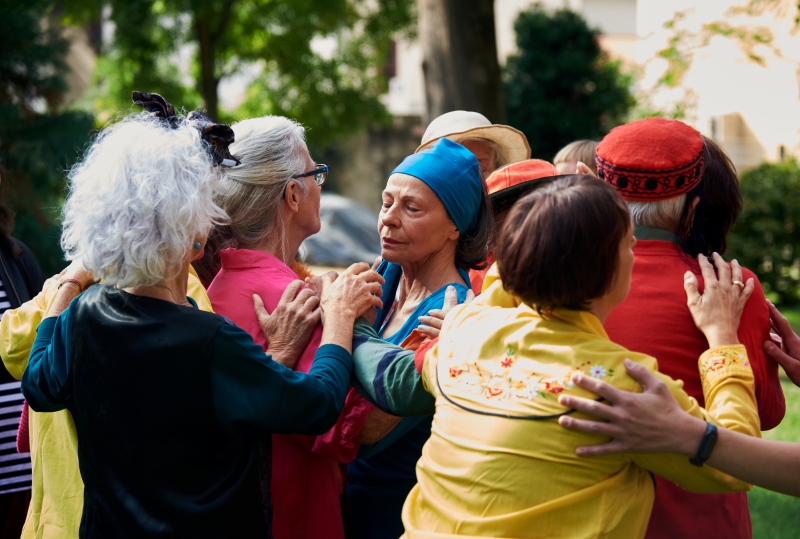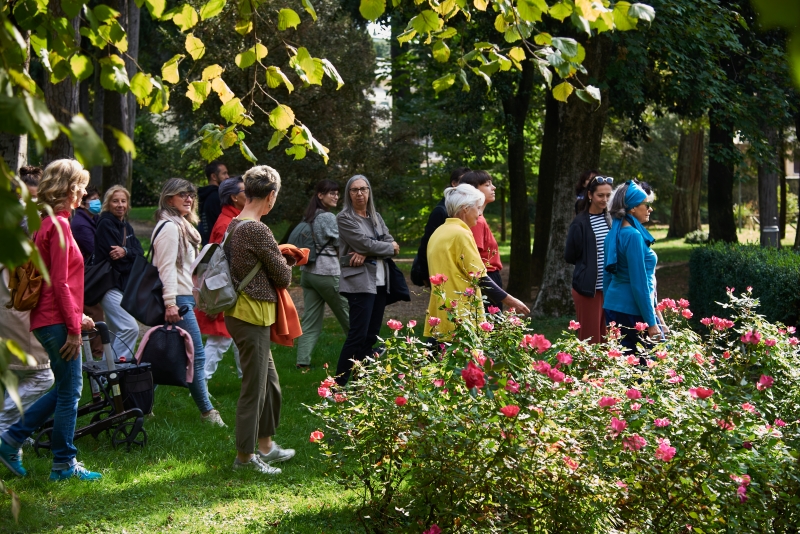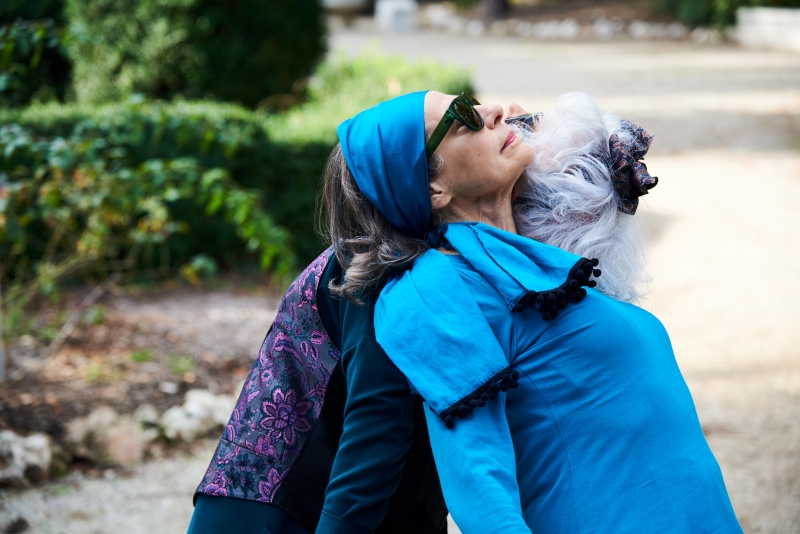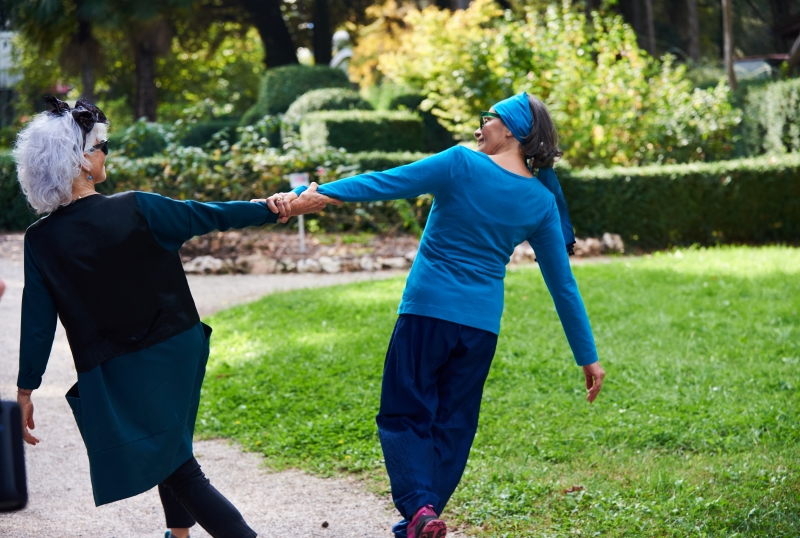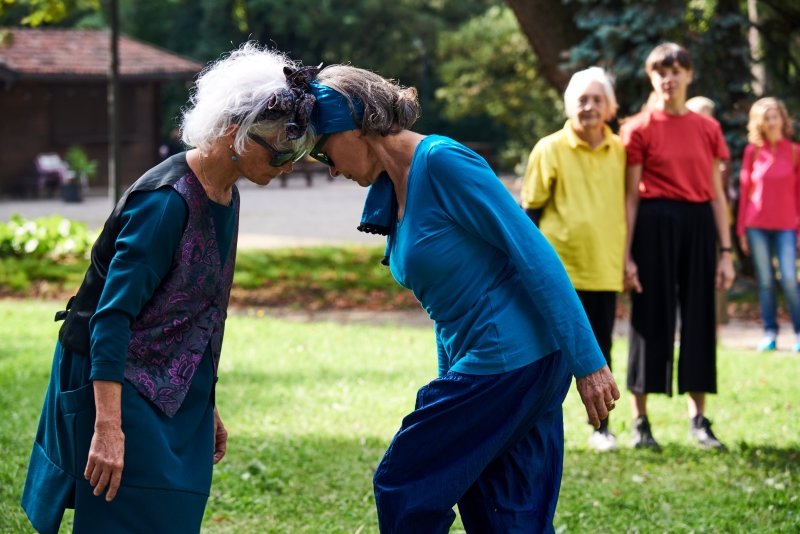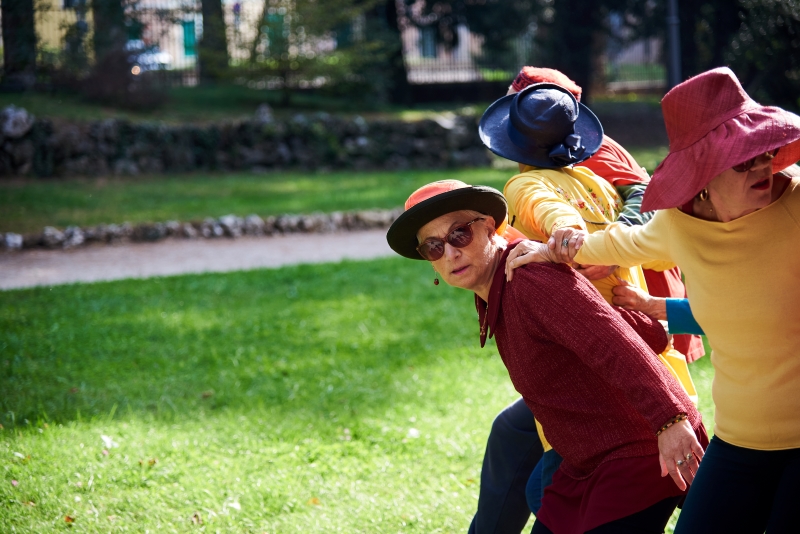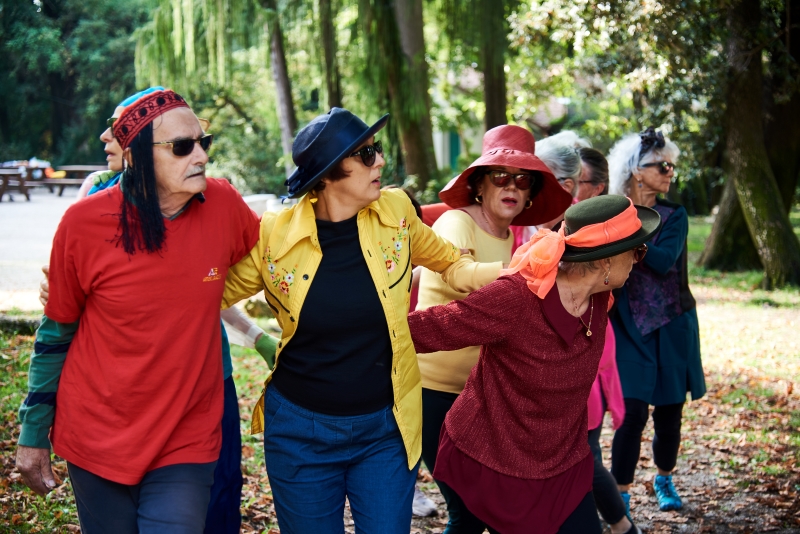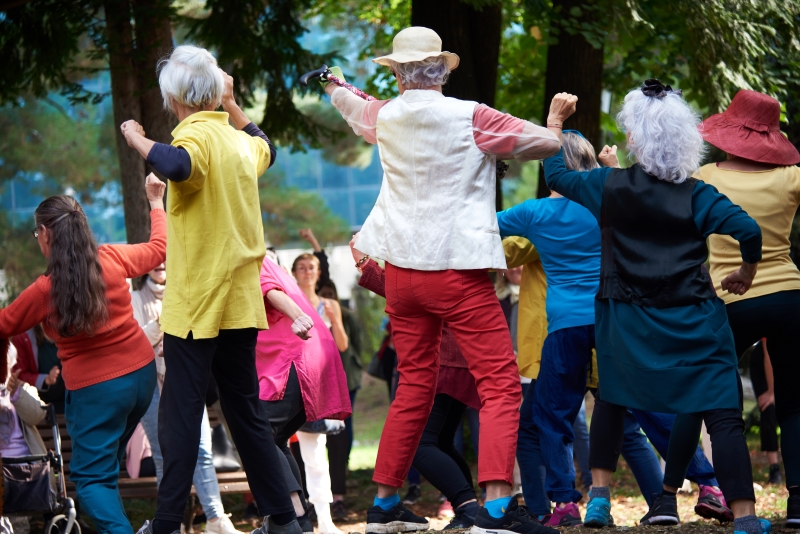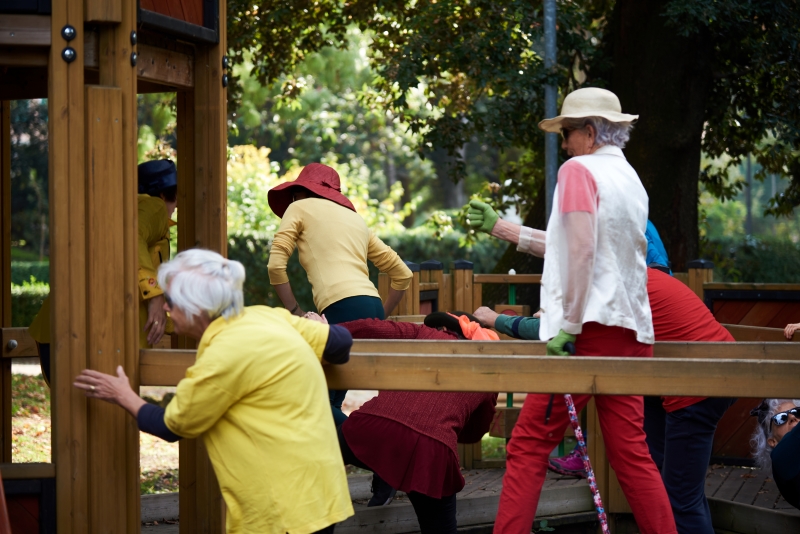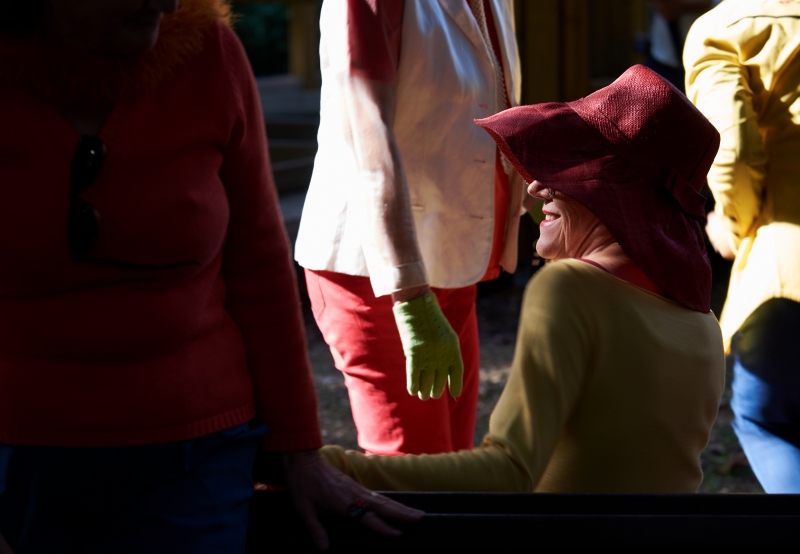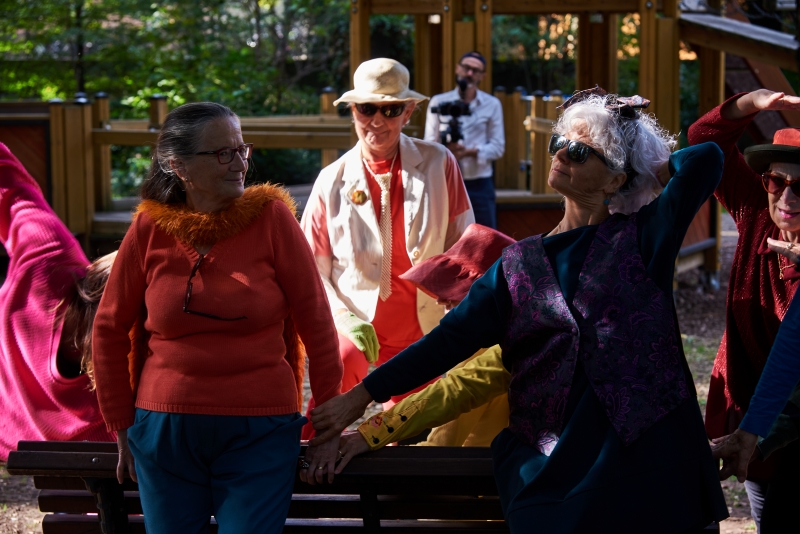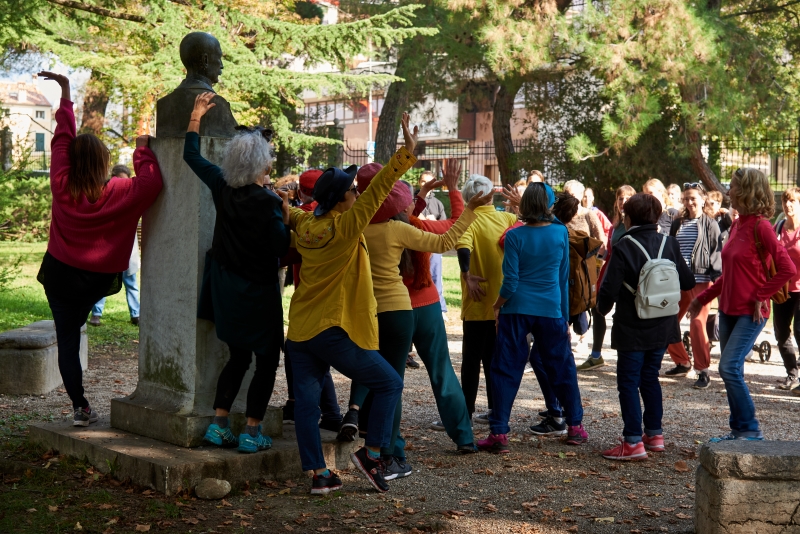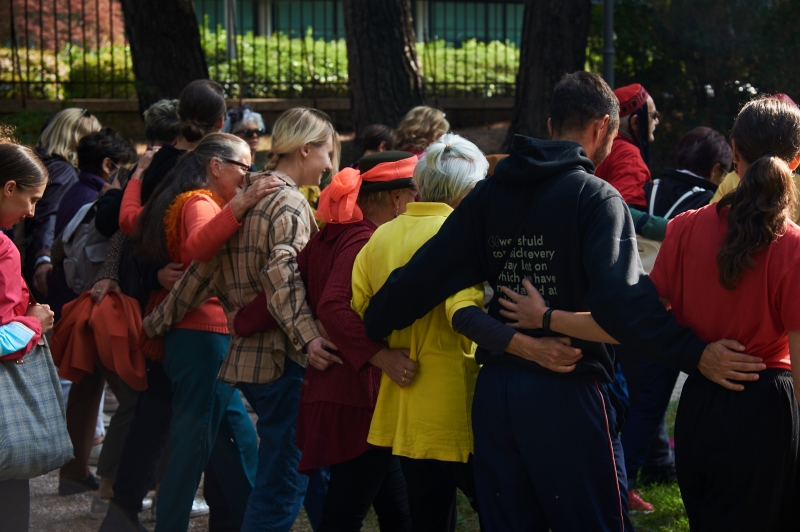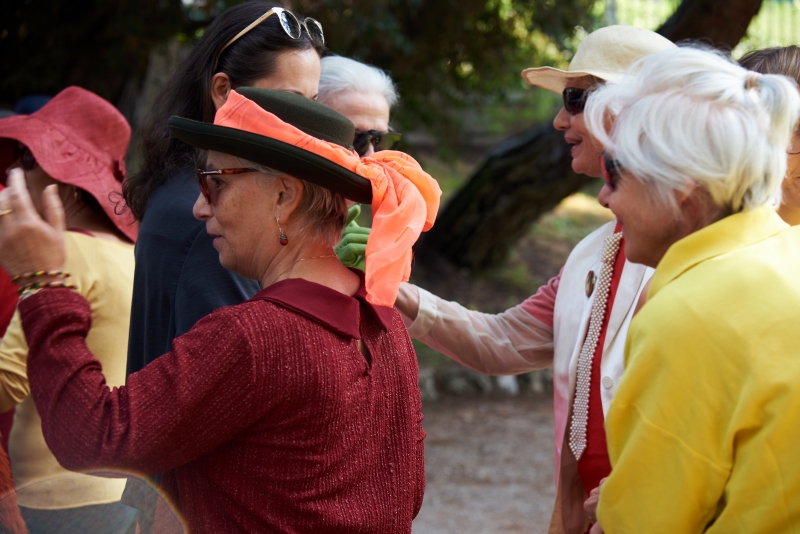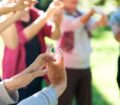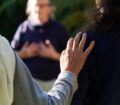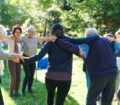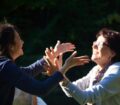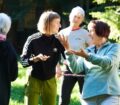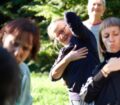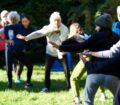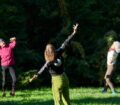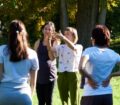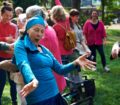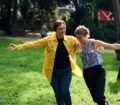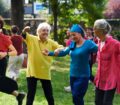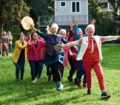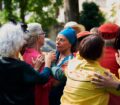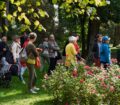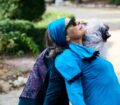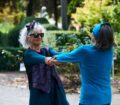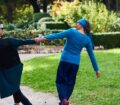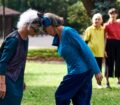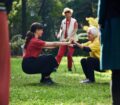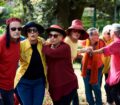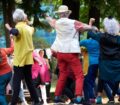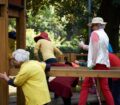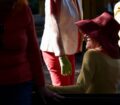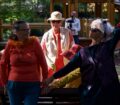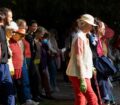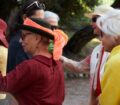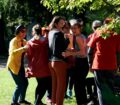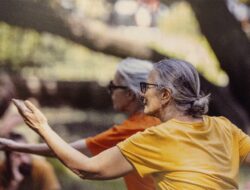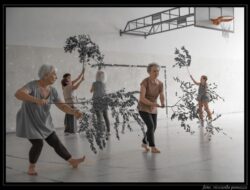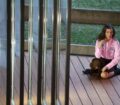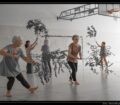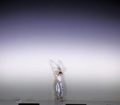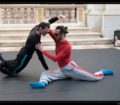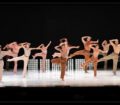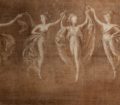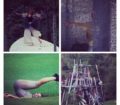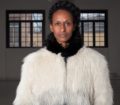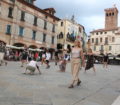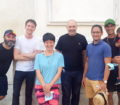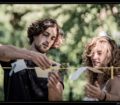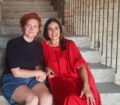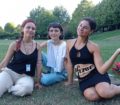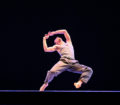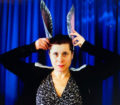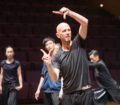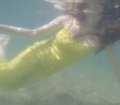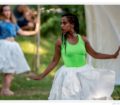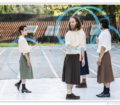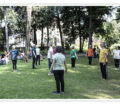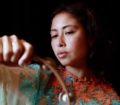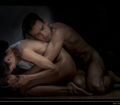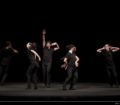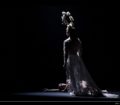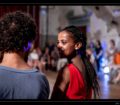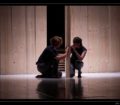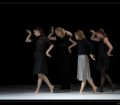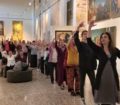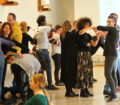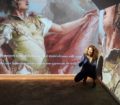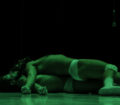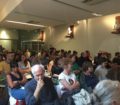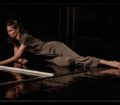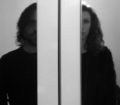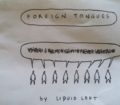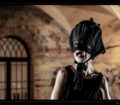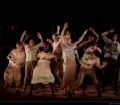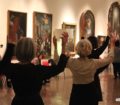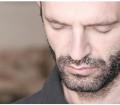Dancing the Horizontal | Giardini Parolini, Bassano del Grappa, 14 October 2022 | It was dance that lit the fuse of joy. The two explosive British choreographers Kate Cox and Rachel Fullegar, founders of the Gracefool Collective, with their playful disruptiveness nourished the already close-knit and divergent bodies of Dance Well with grace and also a pinch of absurdity, agitating them, provoking them, interweaving and disentangling them in an incendiary dances amongst the Giardini Parolini’s sedate shrubs and trees. In creatively flamboyant outfits, all electric colours and odd shapes, Dance Well invaded the prim green space, dappling it with naturalness, levity, light-heartedness. Sometimes in statuesque poses, sporadically in licentious movement, swallowed-up into group compositions, then detonated-out into free dance or dynamic duets, Dance Well interpreted these choreographic and musical inputs hailing from far off Albion, infusing them into their own volatile cocktail of energy.
We interviewed the two choreographers for their story as well as the tale of this unprecedented artistic encounter with Dance Well, the result of “Dancing the Horizontal” (the international exchange and collaboration programme between Yorkshire Dance and the CSC Centro per la Scena Contemporanea of the City of Bassano del Grappa, with the support of the British Council). The result was a lengthy chat covering dance, old age, the body and pleasure, activism, suffragettes and even football’s history with the women’s movement.
“We believe in humour as a powerful tool to transform ideas and undermine social convention.
We believe in collective action as a radical tool for social and political change.
We believe in collective joy as resistance.
We believe in embracing failure.
We believe art should be made everywhere, by everyone, for everyone.
Our work is about serious stuff, without taking itself too seriously.
No to bullshit. No to pretentiousness. Yes to slapstick”.
(Gracefool Collective)
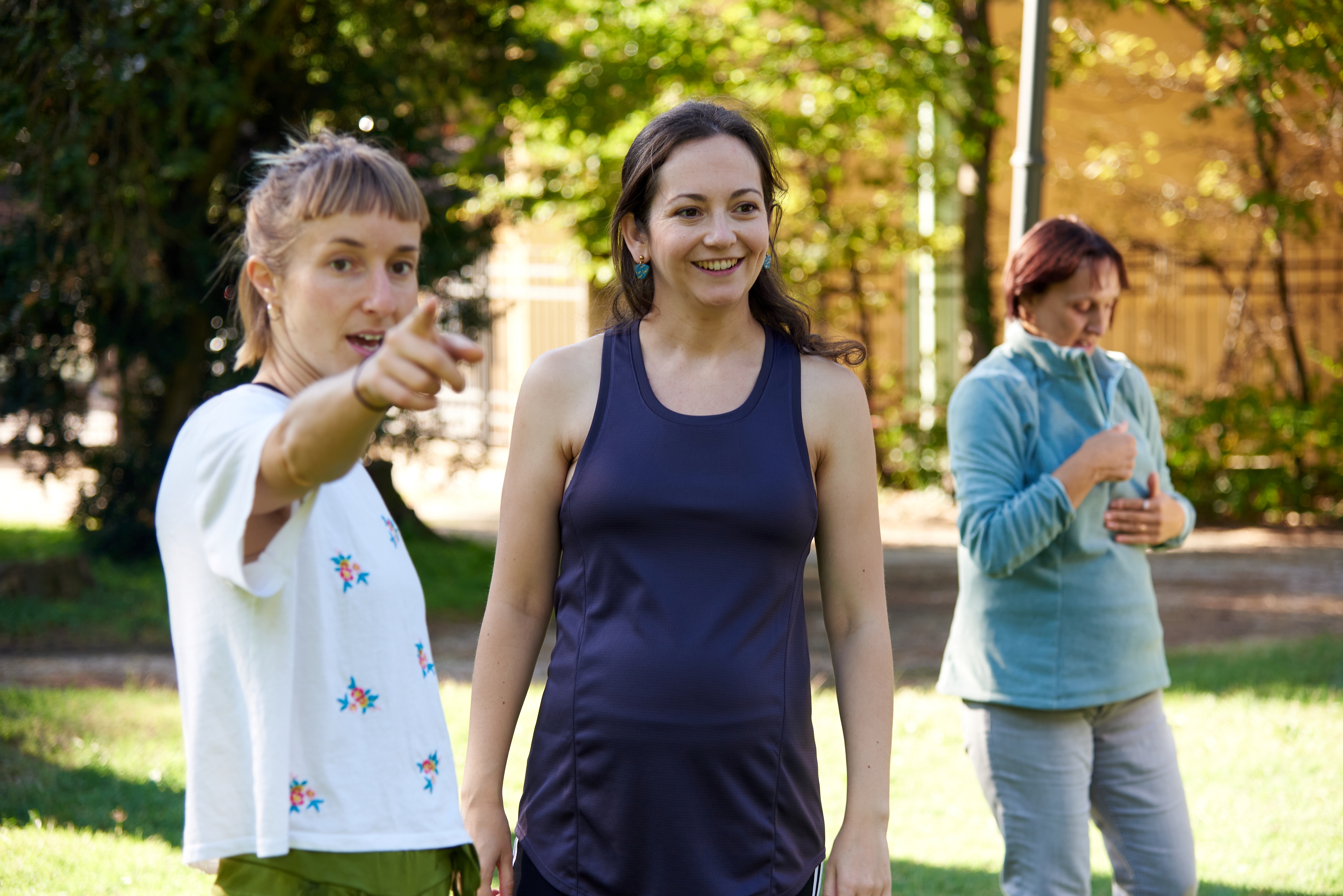
Let’s start with you and your story. You founded the “Gracefool Collective”. What is the starting point of your collective, what is the motivation of your “togetherness”? What is your approach to dance, your specific aesthetic?
Kate: We started working together about ten years ago, when we were studying together at the Northern School of Contemporary Dance [Leeds, UK]. Initially, we were five. We were making a work as part of a course. We had a similar human-centred aesthetic: we used comedy and play a lot in our work because we were bored with a particular kind of contemporary dance aesthetic. There was just old fashioned dance and there was pure dance. We wanted to mix together theatre and speaking and comedy and other things. So, we started doing it all together, so the five of us started messing around with it as a kind of a dialog, I guess. We had not planned to make things as a collective. We also just wanted to stay in Leeds, where we were studying so it was kind of a practical thing that we crossed paths to work together. We got some commissions very early on plus help from some support program. So, we just fell into making work together. But over the years the collective has changed and shifted. Two of our members were Swedish and they had since gone back to Sweden. At the moment it’s just Rachel and I, so it’s just a two-persons collective now [she smiles] — if you can call it “a collective” still!
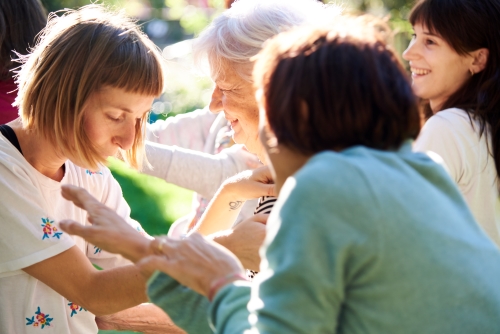 I think, when we came together it was a shared sense of humour and fun and play and not taking dance too seriously, which maybe we found in our training. Contemporary dance at that time in England had a very serious aesthetic, we wanted to do something more playful. So, then we started touring. We had made two professional pieces that we toured, always performing in our own work.
I think, when we came together it was a shared sense of humour and fun and play and not taking dance too seriously, which maybe we found in our training. Contemporary dance at that time in England had a very serious aesthetic, we wanted to do something more playful. So, then we started touring. We had made two professional pieces that we toured, always performing in our own work.
In the last two years, especially after the pandemic, we have started making more work with people and particularly with communities of different people. We started working in Leeds with a group of older adults who called themselves “The Rebel Grannies”. We basically were doing research for a new project with professionals and we did that at the same time as working with adults who were not professional. It is very interesting to explore artistically the same ideas as a kind of practice with a lot of different people, not just professionals. And now we are finding it more interesting to work with people, or at least with a mix of people, that are not trained, because they bring such a different energy to the kind of work that we do.
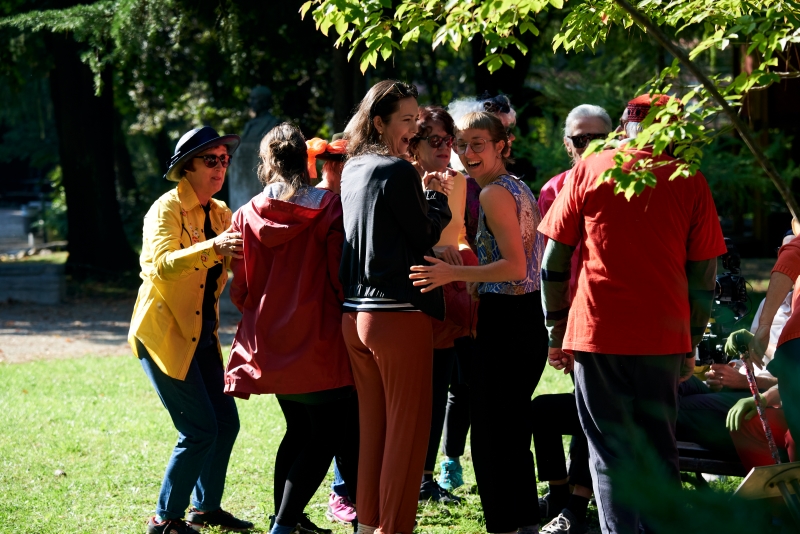
Thanks to the international exchange and collaboration program Dancing the Horizontal, you spent two weeks in Bassano with the Dance Well group. What are you thoughts about your encounter? How was it?
Rachel: It was extremely nourishing for us and for our practice. As already said, we have been interested in bodies which maybe haven’t undergone professional training. This group is so ready and open to new ideas, so ready to perfomance!
On the first day we worked with them, we were doing some tasks. We went quite quickly. They worked-out and then they said: “Yes, what’s next?” I think, one of the things we are very interested in is how our physical practice has developed. We are very interested in struggle and effort and how that can be a really good vehicle for both tragedy and comedy. We find a lot of pathos in that, and catharsis. Of course, trained bodies are trained to hide effort, they pretend that things aren’t hard and, in certain places, try to fit into stereotypical ideas of beauty.
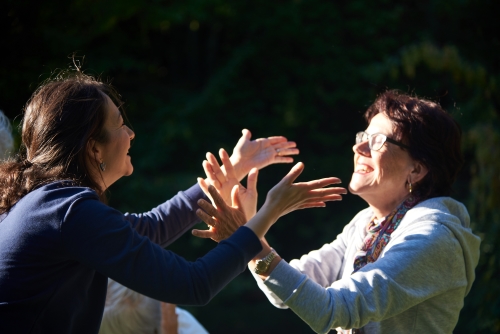 We actually find it more beautiful when there is a real negotiation with the body to attempt something, to try to get somewhere. So, obviously older adults bring two things: one is massive experience in their own bodies — they know themselves so well! They know how their body works and has changed. Also, they are really willing to try and see where their body can still go. So, what we feel we are seeing is that negotiation in practice, trying to get somewhere, and it is so beautiful. So often we are interested in reality. So, we try to put movements on stage, you have to experience effort to do them — whether that might be exhaustion or tension or friction, they are so un-precious and it is really beautiful to watch them.
We actually find it more beautiful when there is a real negotiation with the body to attempt something, to try to get somewhere. So, obviously older adults bring two things: one is massive experience in their own bodies — they know themselves so well! They know how their body works and has changed. Also, they are really willing to try and see where their body can still go. So, what we feel we are seeing is that negotiation in practice, trying to get somewhere, and it is so beautiful. So often we are interested in reality. So, we try to put movements on stage, you have to experience effort to do them — whether that might be exhaustion or tension or friction, they are so un-precious and it is really beautiful to watch them.
We find their approach to the world engaging, because we spoke today about this idea of second childhood, about curiosity and how it comes back, perhaps, more in your old age. And they’re very willing to try and be playful and curious.
 Dance Well told me that they made contact with your dance group in Leeds, is that so?
Dance Well told me that they made contact with your dance group in Leeds, is that so?
Kate: Yes, we had a Zoom meeting with the group that will work with Silvia [Gribaudi, the Italian artist involved in the exchange program] in November 2022. Silvia will come to Leeds to work with some older adults of the Yorkshire Dance Group and classes, the Leeds version of Dance Well I suppose. It has been very fun…!
In your artistic manifesto you declared that you “believe in humour as a powerful tool to transform ideas and undermine social convention”. At the same time, you are really engaged artists: you are activists and feminists. How do you combine your activism with your belief in humour? Can humour help spread activism?
Rachel: Yeah! We are very interested in misbehaving! We have lots of question about how we were expected to be, particularly in public space, as women and particularly as older bodies too. Putting an older body on a playground with play equipment for children is not the expected thing to do. We really like that surprise and permission and finding ways to explore that. A lot of our work in the past has been about women on stage showing how hard it is just to carry on, sweating, being sexual in a different way, being powerful but also showing worry and anxiety and the power of that sharing the reality of what it is to exists. This experience in Bassano is another way for us to explore bodies in space. In the UK, in public spaces, the expectation of older people is really limited.
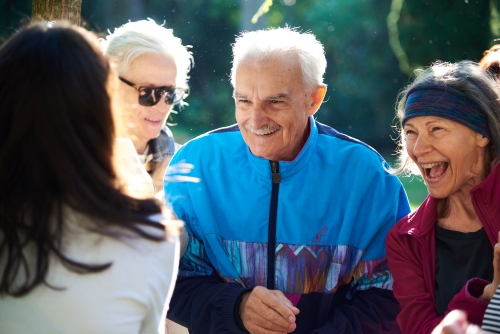 What do you mean?
What do you mean?
Rachel: We have been very struck by seeing older adults in Italy, how they aren’t limiting their time, having a drink with each other, for their socializing, feeling comfortable in public space. We don’t have the same really in the UK. A big problem is lack of public toilets, things like that — I know it sounds stupid.
Kate: Both countries have a very different relation to ageing. In the UK we have a lot of institutions, ten per cent of people are sent away to institutions. Some people just send their parents to care-homes and they just stay there and they can be horrible places. They sometimes feel like being in a kind of prison, I have felt. So, you don’t see older people out that much and we don’t have a very good relationship to public space. Everything has been privatised and there’s not very many spaces to just be outside. I mean, we don’t have such beautiful weather, so we don’t have such a good relation with being outdoors. However, in Italy you have a very different relation with public space. In Italy people feel more ownership over public spaces, that it is a more beautiful space to be in too.
Lots of cities in the UK have been built for consumerism, they have been turned into shopping centres, massive roads, as places for people to consume and buy things in but not places for people to live, exist, and have joy and pleasure and relax — we don’t have so much of that. I think these two things in combination have meant that in the UK we don’t expect to see old people around in places. So there’s more surprise when we see older adults out and about. We are cautious of them, plus we have a strange relationship with ageing and death: we don’t want to confront those issues, they are representations of that so we lock them away. I feel there is more respect for older people in Italy than in the UK and I also feel that in Italy old people take more space, they are more vibrant and vivacious: they believe they should have that space. So, it feels very different.
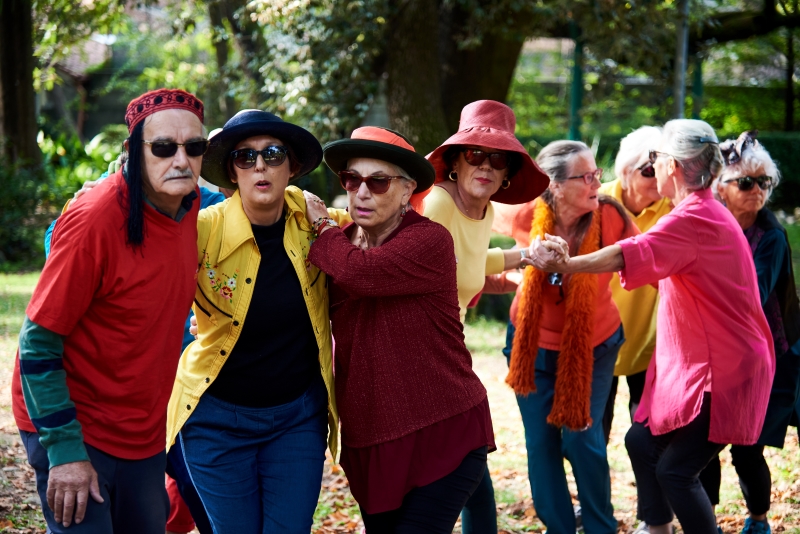
How far can dance impact on older adults’ daily lives? What’s its role? What do you expect from it and particularly from a dance community?
Kate: Yorkshire Dance in Leeds does a really good job in offering a lot of dance projects for older adults and they are very focused on that now.
For me that is a way to break some of these preconceptions of older people, to allow them to connect to their bodies and also to do creative projects where they can take space and they are encouraged to be bold and misbehave and break people’s expectations of what they are supposed to do and how they are supposed to behave (which is basically to be very careful and not take up too much space and not be seen) and to encourage them to do the opposite, to be seen.
Rachel: They have more inside them for us to take notice of and acknowledge and celebrate than I think we have given them permission for in the UK.
We do a lot of power poses and groove and pleasurable moving, allowing them to just reconnect to their feelings as though they are being seen, like: “Watch what I do, watch my body, watch what it’s capable of, watch its history and its experiences, radiate out from the joy I feel for being in this space”.
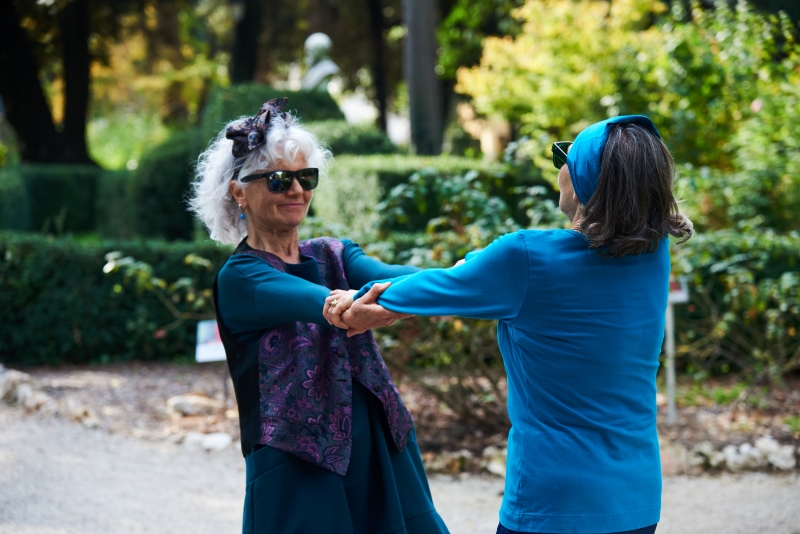
Kate: What happens is that I am deciding that you are watching me and I am choosing to put myself in front of you to be watch. You are watching me not because you think I am not behaving right or because you think I need to be more careful and quite but because I am taking this space and I’ve decided that you will watch me do this thing. There’s something powerful about deciding to do that.
Rachel: We learnt massively from them [Dance Well] — it’s how we want to be, to learn to be like.
Kate: [Laughs in agreement] I hope I am as bold and full of energy as these Dance Well dancers that we have been working with this week. I feel very inspired by that. It is a beautiful thing just to see that they are still so full of energy and life and joy and pleasure at this age. It constantly challenges my own internalised view of ageing, which is like: “Ageing is bad” because that is what I felt that I had been taught in the UK — “Let’s not think about it until we’re there, then let’s send them away!”
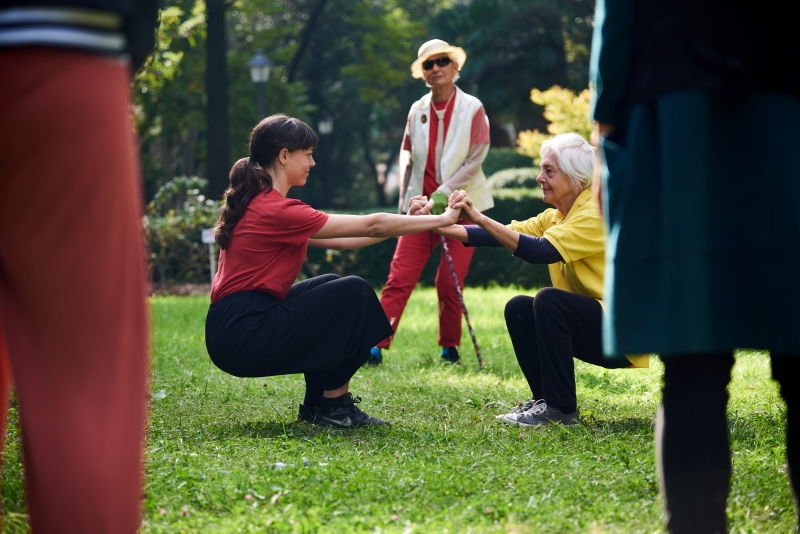
It is a beautiful thing to have inspirational images of people that are older. They are so beautiful and powerful and they still are having fun and making jokes. You know, your life does not stop when you suddenly get to a certain age! There is something about the way we talk about it or don’t talk about it in the UK. People are scared of it and they don’t engage with it and they do not want to think about it. Here I feel it is quite different — I see a lot of examples! Old women are so incredibly stylish here, so much so that I feel underdressed when I see them walking around. And even in their posture and in the way they carry themselves when they walk.
Kate: In the UK you really do not see that. I am not even aware of that. Older people are kind of made invisible people in the UK. Maybe some of the work that Yorkshire Dance is doing through this kind of dancing is trying to let them become more visible, and allow them to decide how they are seen. Not just to see them as little old ladies but as powerful and beautiful people who are allowed to take as much space as anyone else.
I think there is something that dance can do to encourage this in the UK. I definitely see it in the older adults we have worked with through dance projects. They all have been encouraged and invited to do that more and it seeps into them.

If you should send a postcard from Bassano right now, what would you write on it?
Rachel: Maybe I would just have a picture by the fountain [at the Garibaldi square], with a huge line of these stylish, amazing Dance Well women (and of course Mario) like amazing statues from ancient Greece or Rome, goddesses lounging and reclining and drinking spritz in the afternoon with nonchalance, with the beautiful backdrop of the mountains. Luxury, pleasure…!
Kate: Yeah, pleasure! There is something about pleasure: you can still find pleasure in your life, through all of your life. I think what we took from dancing this week is that they [Dance Well] were taking so much pleasure from that, from dancing and from being seen. And I want to encourage them more…
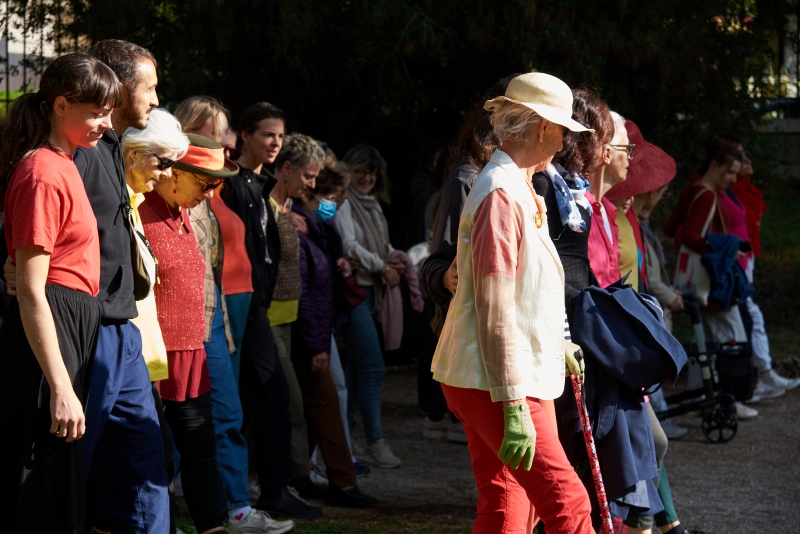
What about your next project? Do you have something in the pipeline?
Kate: In these days we have been preparing an Arts Council application for a commission we have next year [2023] which we have some money towards but want to do a big version of the project. It will be an outdoor project with older adults and also with some professional dancers and some younger women. It will be an intergenerational piece in theory. We were also shortlisted for the Women’s Football Euro cultural programme last year. In the end we didn’t do it but we developed a project which was based around the history and physicality of women’s football.
Rachel: In the UK it has a particularly interesting history due to the fact that women’s football was linked to activism.
Do you mean suffragettes?
Kate: Yeah. There was a lot of women who played football and who were also suffragettes.
Rachel: One of the problems is that so many women were taking up football and men didn’t like to see women bodies in spaces existing differently, different skills and prowess. It drew huge crowds, women’s football was almost becoming more popular than the men’s game, and so they banned it for years and years.
Kate: Part of the reasons they banned women’s football was because it was so popular, they were worried that people would be drawn into their politics and that people, after seeing them, might say: “Yeah, they should get the vote!”. It is a very interesting history and it is a very interesting kind of physicality. So, we will explore that a bit with three generations of women: older women, some young professional dancers and – we hope- some young girls who play football.
Rachel: Because there’s an academy for the women’s team in Leeds.
When will the debut of this project on women’s football be?
Kate: It will be in the summer of 2023, part of a “Year of Culture” in Leeds.
Interview and editing by Anna Trevisan
English translation and proofreading by Jim Sunderland
Cover image and photo-gallery by Anna Kushnirenko


